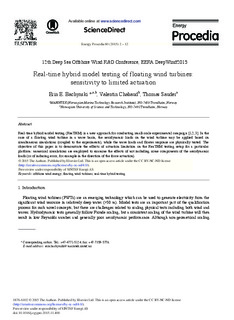| dc.contributor.author | Bachynski, Erin Elizabeth | |
| dc.contributor.author | Chabaud, Valentin Bruno | |
| dc.contributor.author | Sauder, Thomas Michel | |
| dc.date.accessioned | 2015-12-03T14:54:54Z | |
| dc.date.accessioned | 2015-12-10T13:14:52Z | |
| dc.date.available | 2015-12-03T14:54:54Z | |
| dc.date.available | 2015-12-10T13:14:52Z | |
| dc.date.issued | 2015 | |
| dc.identifier.citation | Energy Procedia 2015, 80:2-12 | nb_NO |
| dc.identifier.issn | 1876-6102 | |
| dc.identifier.uri | http://hdl.handle.net/11250/2367476 | |
| dc.description.abstract | Real-time hybrid model testing (ReaTHM) is a new approach for conducting small-scale experimental campaign [1], [2] and [3]. In the case of a floating wind turbine in a wave basin, the aerodynamic loads on the wind turbine may be applied based on simultaneous simulations (coupled to the experiments), while the wave loads and floater response are physically tested. The objective of this paper is to demonstrate the effects of actuation limitation on the ReaTHM testing setup for a particular platform: numerical simulations are employed to examine the effects of not including some components of the aerodynamic loads (or of inducing error, for example in the direction of the force actuation). | nb_NO |
| dc.language.iso | eng | nb_NO |
| dc.publisher | Elsevier | nb_NO |
| dc.title | Real-time hybrid model testing of floating wind turbines: sensitivity to limited actuation | nb_NO |
| dc.type | Journal article | nb_NO |
| dc.type | Peer reviewed | en_GB |
| dc.date.updated | 2015-12-03T14:54:54Z | |
| dc.source.volume | 80 | nb_NO |
| dc.source.journal | Energy Procedia | nb_NO |
| dc.identifier.doi | doi:10.1016/j.egypro.2015.11.400 | |
| dc.identifier.cristin | 1286398 | |
| dc.description.localcode | © 2015 The Authors. Published by Elsevier Ltd. This is an open access article inder the CC BY-NC-ND license. | nb_NO |
